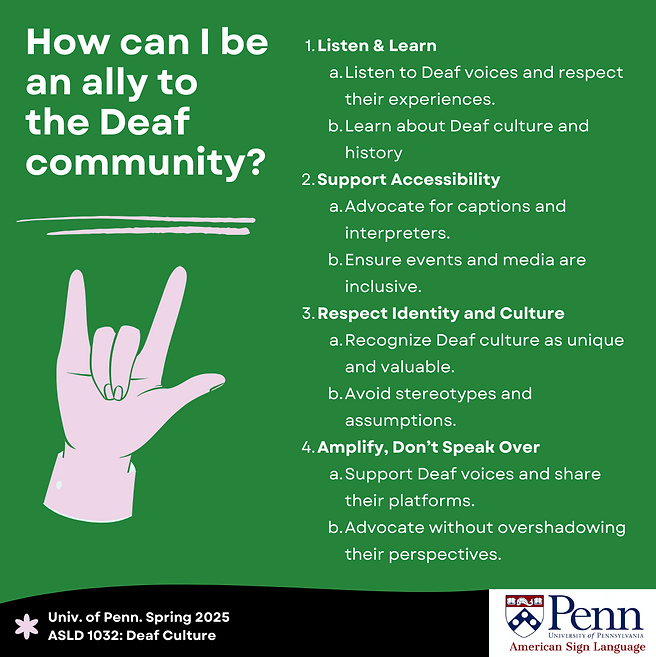How Can I Become an Ally?
It's easy to say that one wants to be an ally, but what does allyship truly entail? And how can one be an ally to the Deaf community specifically? Scroll to learn some etiquette about interacting with the Deaf community, as well as how to educate oneself in becoming more aware of the Deaf community.
.png)
1. Listen and Learn
Respect Deaf experiences, first and foremost. Learn about historical events prominent to the development of Deaf culture, such as the Deaf President Now! protest, the Milan Conference of 1880, the Unity for Gallaudet Movement, and the establishment of the National Association of the Deaf (NAD). Take initiative and put the effort in to learn ASL; don't put the responsibility on a Deaf person be the one to teach.
Learn about the timeline of Deaf Culture here
Read about Deaf Awareness by the National Deaf Center here
3. Respect Identity and Culture
One aspect of Deaf Culture is the idea of Deaf Gain, which seeks to showcase the advantages of being deaf in a positive way. Avoid stereotyping the Deaf community with assumptions like "Deaf people are less intelligent", and learn about what Deaf people CAN do (which is everything a hearing person can, except hear).
Listen to a podcast/read its transcript about Deaf Gain here
Read debunked myths about Deaf people here
2. Support Accessibility
Advocate for captions on digital and social media and ensure
that captioning is not delayed or obstructed. If hosting
community events, hire an interpreter to increase accessibility.
Include Deaf representation in films, books, and other forms
of media you create, and support Deaf creative projects.
Watch the movie CODA here
View a list of books by Deaf, DeafBlind, and Hard of Hearing authors here
4. Amplify, Don't Speak Over
When communicating with a Deaf person, let them set the communication style. Raise awareness of Deaf content creators on social media by sharing their content, but don't overwrite their experiences with your own. Include Deaf people in your conversations to ensure equal representation in perspectives shared.
Learn about 10 Deaf TikTok Influencers here
Keep up with Deaf news in ASL through the Daily Moth here

Helpful Words to Know
Here are some sentences and their glossed translations you should have in your back pocket:
Hi! My name is ____
HELLO, ME NAME ____
I'm a student learning ASL.
ME STUDENT, LEARN ASL
I'm sorry, I don't understand. Can you repeat that, please?
SORRY, ME NOT-UNDERSTAND. AGAIN, PLEASE?
I'm sorry, I don't understand. Could you sign it slower, please?
SORRY, ME NOT-UNDERSTAND. SLOWLY, PLEASE?
Should I write it out instead?
PAPER ME WRITE?
Conversation Starters
Here are a few topics you could use if the conversation stalls. Feel free to tailor them to the event you're attending!
Introduce yourself.
Ask how their day was.
Ask what their hobbies are.
Ask where they grew up/where they're from.
Ask about their family.
Ask about sports or recent events, like what they did to celebrate a holiday.
Ask about their dream vacation.
Confidence tip: practice signing these questions (and your own answers!) in a mirror before you attend your event, so you can feel more natural pulling them out when you need it.